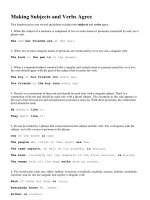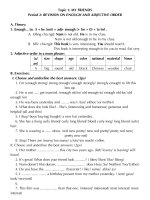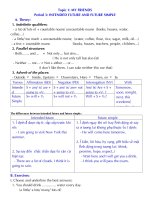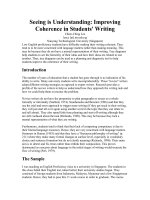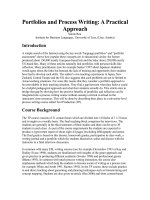Portfolios and Process Writing.doc
Bạn đang xem bản rút gọn của tài liệu. Xem và tải ngay bản đầy đủ của tài liệu tại đây (84.8 KB, 8 trang )
Portfolios and Process Writing: A Practical
Approach
Simon Rea
Institute for Business Languages, University of Linz, (Linz, Austria)
Introduction
A simple search of the Internet using the key words "language portfolios" and "portfolio
assessment" shows how popular these concepts are in educational circles: the former
produced about 150,000 mostly European-based hits and the latter about 250,000 mostly
US-based hits. Many of these articles naturally link portfolios with personal skills like
reflection. Many practitioners (see for example Santos' 1997 about Japanese students)
would agree about the links but bemoan the lack of training and opportunity their students
have had to develop such skills. The author's own teaching experiences in Japan, New
Zealand, Central Europe and the UK also suggests that such problems are not to limited to
Asian teaching situations. For some this means that they consider a portfolio approach to
be unworkable in their teaching situation. They find a gap between what they believe could
be a helpful pedagogical approach and what their students actually do. This article aims to
bridge that gap by showing how the positive benefits of portfolios and reflection can be
integrated into a process writing course without causing a critical overload on the
instructors' time resources. This will be done by describing their place in a university-level
process writing course called Text Production (TP).
Course Background
The TP course consists of 21 contact hours which are divided into 14 blocks of 1 1/2 hours
and is taught on a weekly basis. The final teaching block comprises the interviews. The
students are generally in the third semesters of their studies and there can be up to 30
students in each class. As part of the course requirements the students are expected to
produce a typewritten report of about eight A4 pages (excluding bibliography and notes).
The final grade is based on this dossier, homework grades, participation in class work, a
writing journal and a portfolio which the students themselves select and discuss with the
instructor in a final interview discussion.
In common with many ESL writing courses (see for example Flowerdew 1993 or Kay and
Dudley-Evans 1998), students are familiarised with insights of the genre approach and
given practice in producing different academic (Swales 1990) and professional genres
(Bhatia 1993). In common with much process writing instruction, the course also
emphasises methods which help the students to become aware of writing as a process (see
for example White and Arndt 1991, Raimes 1992). In the TP course, these include practice
in and direct teaching about generating and planning techniques such as brainstorming and
concept mapping. Students are also given an article (Rea 2000) and short content-based
inputs about writing as a process. These theoretical inputs are linked to the tape of a think-
aloud protocol of a short text being written which the students listen to and then talk about.
Text reformulation (Cohen 1983, Allwright et al 1988) is used to encourage students to
look at their own writing critically. In a first stage, the students work on set texts, including
introductions and conclusions of dossiers from previous years, which are read, corrected
for surface level errors and then rewritten. They do this first as individuals and then discuss
the results as a whole group. Following this, the students read and rewrite different sections
of each other's texts, using the insights they have gained from the class discussions. After
that they go on to re-formulate their own work based on the insights of their colleagues
(and the instructors) rather than just correct it for grammar and spelling mistakes.
Reformulation obviously helps students to become aware of external readers and this is
reinforced with video and text-based input (Littlewood 1994).
Journal writing and fastwrites are also integral parts of the course. In both activities the
students can prepare for the final interview without being aware that they are doing so
because both activities can by their very nature be very reflective. There are two
compulsory fastwrites. Both take seven minutes and are on the topic "How I write ...". One
is written in the first meeting and the other in the final professional writing workshop.
These very often show the development of the students' writing skills. Some students use
fastwrites in their writing journals too.
The writing journal is a kind of "personal diary" (cf Raimes 1992) where the students can
write about their experiences and feelings about writing in general and this course in
particular. Students are told that it has two main purposes, namely to make students feel at
ease writing in English and to give them the chance to express themselves. For these
reasons, it does not have the relatively tight structure recommended for example by Nunan
(1988) who suggests a number of questions which students should answer about their
learning. This is because the diary aims to help the students overcome "writing anxiety", as
well as to help them focus on their learning processes. It does this by modelling the type of
writing students can do in the way the activity is introduced and in the fast writes. They are
expected to spend about five to ten minutes a day (or 30-60 minutes a week) on this
writing. The journal can be written by hand or with the computer. It is evaluated for
quantity rather than quality. Because of the personal nature of some of the comments, the
instructor only looks at the journal if the students request this or add it to their portfolios.
Portfolios
What then are the portfolios and how do they fit in? The answer is that they provide a
framework for the whole course. In the schedule they get at the start, students are told that
they will prepare a portfolio of their best work during the semester which they will discuss
with the instructor in a personal interview at the end of the semester. It should document
their progress (as measured by their subjective feelings and the amount of effort they have
put into the course); their achievement (as measured by the "objective" grades they have
been given during the semester); and any other information they believe is relevant. In this
way the course begins and ends with a portfolio focus.
The portfolio consists of six pieces of written work including a written self-evaluation, the
eight-page research dossier and three pieces of work of the students' own choice. The
written self-evaluations tend to be in the form of memos or letters to the instructor. It is,
however, up to the individual student to chose which genre suits him or her best. Some
students even choose to write a mini-case study with a SWOT analysis, explaining their
strengths, weaknesses, opportunities and threats in writing. Appendix 3 shows two typical
self-evaluations. Together the portfolio and the interview account for 50% of the final
grade.
The three pieces of work of their own choice may be taken from any of the work they have
done during the semester. They may be work they have done in-class or as homework.
They may be from any part of the course and include the introduction and/or conclusion
with their reformulation versions or even their writing diary or any two of the fast-writes. It
is completely up to them.
Teacher's Viewpoint
The portfolio discussion interviews tend to follow a similar framework: starting with a
focus on the students' view of the process of writing, then moving on to their choice of
work and/or specific course features and finishing with their self assessment. The order is
not always the same but all three elements tend to be present, as the idea is to allow the
students to talk quiet freely and bring in their own views on what and how they have
learned during the course. This is similar in effect to the "interlocutor frames" given for
examinations such as the Cambridge Advanced English (see
for more details). Such a framework makes it easier to judge students' oral abilities, as the
content variable is not given to the same extent as in subject-based oral examinations or
presentations. As far as grading is concerned, the students' spoken performance in this
relatively content-controlled environment can easily be benchmarked against
internationally-recognised marking scales such as those from the Council of Europe
( or the Association of Language Testers in
Europe (), which is also used in examinations like the CAE.
The process questions focus on how they chose the pieces of work for their portfolio. More
mature students tend to start with the developmental aspect as they have generally chosen
texts with both good and poor grades while less reflective students will tend to put all the
good grades together and focus only on the product aspect. With the former group of
students it is relatively easy to have a good discussion and fruitful and honest reflection.
The latter group sometimes needs to be reminded of the in-class discussions about learning
before this can take place. This can also be done by asking them directly about their choice
and getting them to reflect on what makes each piece of work good. Moving on to the
"most useful activities from your (=the student's) point of view " can also help to move the
discussion from a product to a process perspective. When this has happened it is much
easier for the students to focus on reflection than negotiation and trying to play the system.
Using portfolios in this way has both strengths and weaknesses. On the negative side is of
course the amount of time needed with between 15 minutes per student and a short break
between each one. This can lead to a certain "portfolio fatigue" on the instructor's part,
generally after the first six or seven interviews. In turn this may lead to the instructor
dominating the discussion and not allowing the students to express themselves in their own
way.
For some students any such interview situation can be stressful and this may affect their
performance. As noted above, some students make use of the interview as an opportunity
for "plea bargaining" about their grades while others may try to be sycophantic in the hope
that this will improve their grades. However, such problems are common to almost all
internal viva voce examinations.
On the other hand, the strengths of this approach include the real "quality time" given to
each student as an individual. This is in a situation where they must talk and they have
"nowhere to hide". Additionally, it means that students have to reflect on learning as a
process and can help them to see their own strengths.
These discussions are also very useful for the instructors as it is possible to get a more
detailed "consumer feedback" on the course than is otherwise possible. They can learn
about student effort and difficulties which can lead to better preparation and more effective
materials.
Conclusion
This article has presented a way to integrate portfolio approach into a process writing
course. Portfolios by their very nature require reflection on the part of those who are
putting them together, be they students (Santos 1997) or teachers (Bastidas 1997). While
many students in Austria have not been trained to reflect on their learning, process writing
techniques, especially activities like reformulation and journal writing can encourage them
to do so. The value of reflection in learning processes has long been recognised in
management education (eg. Argyris and Schön 1978). The portfolio-based personal
interview between students and instructors can lead to the start of consciously self-
analytical deutero-learning cycle which can then be applied in other situations as well.
When this happens, the text production has done more than just help students with their
English.
References
• Argyris, C. and Schön, D A. 1996. Organisational Learning: A Theory of Action
Perspective. Massachusetts: Addison-Wesley
• Allwright, R.L., Woodley, M.., and Allwright, J.M. 1988. "Investigating
Reformulation as a practical strategy for the teaching of academic writing." Applied
Linguistics 9/3: 236-256.
• Bastidas, J. A. 1996. The teaching portfolio: A tool to become a reflective teacher."
English Teaching Forum. July/October: 24-28.
• Bhatia, V.K. 1993. Analysing Genre: Language use in professional settings.
London: Longman.
• Cohen, A.D. 1983. "Reformulating compositions." TESOL Newsletter 17/6: 15.
• Daley and Hailey 1984. "
• Flowerdew, J. 1993. "An educational or process appraoch to the teaching of
professional genres." ELT Journal 47/4: 305-316.
• Kay, H.L. and Dudley-Evans, T. 1998. "Genre: What teachers think." ELT Journal
52/4: 308-314.
• Littlewood, W. 1994. "Reading and writing as a joint journey through ideas." Video
of Paper given at Reading and Writing Research International Conference
Southeast Asian Ministers' of Education Organisation Regional Language Centre
Singapore.
• Nunan, D. 1988. The Learner-centred Curriculum. Cambridge: Cambridge
University Press.
• Raimes, A. 1992. Exploring through Writing: A Process Approach to ESL
Composition 2nd ed. New York: St. Martins Press
• Rea, S. W. J. 1999. "Picture this: Three pictures in search of a process." English
Language Teaching News (British Council / TEA).
• Santos, M. 1997. "Portfolio Assessment and the role of learner reflection." English
Teaching Forum. April: 10-14.
• Swales, J.M. 1990. Genre Analysis - English in Academic and Research Settings.
Cambridge: CUP.
Appendix I
This sheet is handed out and discussed during the first course meeting.
COURSE PORTFOLIO
As part of the course you will be expected to produce a portfolio of your work during the
semester. You will discuss it with the instructor in an interview of about 10 minutes on
________________
The aim of the portfolio is to give you a chance to show the progress you have made during
the semester. The aims of the portfolio and the interview are to show your progress during
the semester.
The portfolio will consist of 5 pieces of written work. These will include:
1. A written self-evaluation
2. Your dossier (final version)
3. 3 pieces of work.
You will also have to show the instructor your writing journal during the interview. The
writing journal will not be read by the instructor unless you want it to be!

